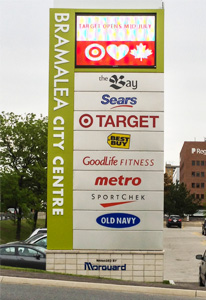 By Robert Blyth
By Robert Blyth
The light-emitting diode (LED) display industry is converging today toward tighter pixel pitches in the interest of achieving greater resolution, such that 20-, 28- and 34-mm (0.8-, 1.1- and 1.3-in.) pitches now seem much less appealing than in the past. After all, a business owner looking for a sign may wonder, how could a 20-mm pitch be better than a 10-mm (0.4-in.) pitch?
Specifying the right display for the right application, however, involves debunking the hype for ever-tighter screen resolutions, which are not necessarily the right answer simply because they represent the latest technology.
Each LED display has a specific purpose. Sign customers need to be properly advised of the facts so they can make value-based economic decisions.
Limitations of tighter pitches
The International Sign Association’s (ISA’s) 2014 International Sign Expo provided a glimpse of the future with a 1.2-mm (0.05) pixel pitch display. The screen resolution was impressive. Standing only a few feet away, one could easily be convinced one was looking at a very large plasma screen.

Some LED displays need to be visible to drivers far away, while others are intended for pedestrians in closer vicinity.
Yet, the technology was not without its drawbacks. There were significant fluctuations in colour from one side of the display to the other, for example, and the longevity of the screen was rated for only three years with a maximum luminance output of 2,500 candelas per square metre (cd/m2).
As a result, this very expensive screen could only be used indoors and for a limited period. In the commercial sign industry, however, LED displays need to be installed outdoors to serve as electronic message centres (EMCs)—and customers have a limited budget.
Calculating viewing distance
Factory representatives commonly raise the issue of what pixel pitch is right for the sign’s height on a pole or wall, but the real deciding factor is the ideal ‘true viewing distance’ (TVD). This can be calculated through simple right-angle trigonometry based on both the height of the sign and the horizontal distance to the viewer (see Figure 1). In many cases, a greater installation height has only a negligible effect on TVD and thus no bearing on determining the ideal pixel pitch for the display.
Increased height can mean increased visibility, to a certain extent, but this has more to do with standing out from visual pollution than with pixel pitch. In most cases, after all, the display is intended to be seen from as far away as possible, to allow maximum time to achieve impressions on passersby for advertised products and services.





